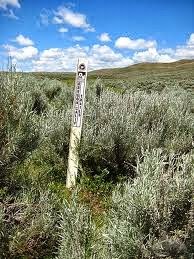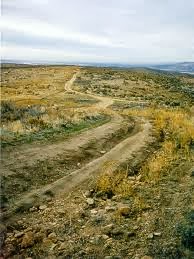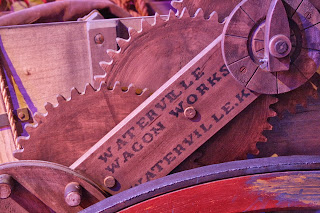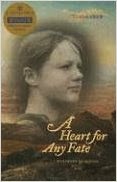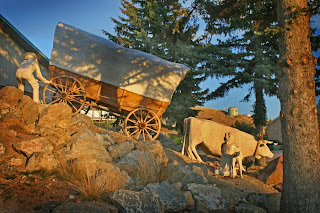Sunday, October 27, 2013
THINGS ARE A CHANGING ON THE OLD OREGON TRAIL
Things and seasons are changing here on the Oregon Trail, in Montpelier, Idaho, This past weekend it has been in the high 60's which is warmer than normal for October. It has made it nice to complete all the outside projects that need wrapping up for the winter.
The golden days of summer have passed so quickly. It seems like yesterday that graduation and Memorial Day Celebrations were upon us.
Tonight the Rocky Mountains are to get their first official blizzard. The picture above is what our area looks like during winter. No wonder the pioneers moved on to Oregon!
Tuesday, October 22, 2013
CAN I STILL SEE THE OREGON TRAIL TODAY?
Many travelers want to touch and feel the Oregon Trail today. They will often ask where they can so this. Below are some ideas and pictures to help anyone who would like to retrace the footsteps of the Oregon/California Trail Pioneers.
The Oregon California Trails Association has marked all of the existing Oregon/California Trail with the markets pictured above.
Another sign to look for are the Historical Scenic Byway signs. This is what they look like in our Bear Lake Valley. When you pick up the brochures that have this logo on them, they will offer historical verbiage about historical points along your route.
Above are some of the most famous, and vivid ruts still in existence today. These ruts are found in Guernsey, Wyoming. They are worn in solid rock. They are not to be missed as you can actually walk these ruts and touch and feel the trail.
More often than not the ruts pictured above are the ones you will see along most highways today. They are visible to the naked eye. Thanks to the hard work and efforts of the Oregon California Trails Association you will know you are on the right trail if you be sure to look for the markers in the first picture of this blog.
Happy Trail Hunting!
The Oregon California Trails Association has marked all of the existing Oregon/California Trail with the markets pictured above.
Another sign to look for are the Historical Scenic Byway signs. This is what they look like in our Bear Lake Valley. When you pick up the brochures that have this logo on them, they will offer historical verbiage about historical points along your route.
Above are some of the most famous, and vivid ruts still in existence today. These ruts are found in Guernsey, Wyoming. They are worn in solid rock. They are not to be missed as you can actually walk these ruts and touch and feel the trail.
More often than not the ruts pictured above are the ones you will see along most highways today. They are visible to the naked eye. Thanks to the hard work and efforts of the Oregon California Trails Association you will know you are on the right trail if you be sure to look for the markers in the first picture of this blog.
Happy Trail Hunting!
Sunday, October 20, 2013
MORE PICTURES FROM THE NATIONAL OREGON/CALIFORNIA TRAIL CENTER
The National Oregon/California Trail Center is home to some very talented people. One such person is Bruce Grayum, photographer.
Bruce lives near the center and holds a full time job as a desk clerk at the Super 8 motel across from the center. Bruce's love is photography. Below will be some views of the center through the lens of his camera. Enjoy!
These pictures are from our Living History Tour that you can be a part of May 1st to October 15th, every half hour.
If you have enjoyed Bruce's perspective on the Clover Creek Encampment Site, please feel free to visit his 365 project at: 365project.com/Bruce Grayum.
Thursday, October 17, 2013
SEEING THE ELEPHANT
I am often asked the meaning of the term "Seeing the Elephant", used by Oregon Trail Pioneers.
The term, "Seeing the Elephant" was a way of expressing on overwhelming emotion. As historians have researched the pioneer diaries they were quick to sum up the expression as a negative experience.
While desolation and sadness may have been the one trait of seeing the elephant, there were others who recorded this same phrase for the excitement they felt about embarking on an unknown journey. Elephant sightings often began with excitement and anticipation, only to be disappointing or disheartening. The highs of excitement were often followed by the lows of frustration. While most wanted to see the Elephant, few would have wanted to "see" it again.
The term, "Seeing the Elephant" was a way of expressing on overwhelming emotion. As historians have researched the pioneer diaries they were quick to sum up the expression as a negative experience.
While desolation and sadness may have been the one trait of seeing the elephant, there were others who recorded this same phrase for the excitement they felt about embarking on an unknown journey. Elephant sightings often began with excitement and anticipation, only to be disappointing or disheartening. The highs of excitement were often followed by the lows of frustration. While most wanted to see the Elephant, few would have wanted to "see" it again.
Sunday, October 13, 2013
WHY PRESERVE HISTORY?
Working as the Executive Director of the National Oregon/California Trail Center, I often cross paths with hundreds and hundreds of people each summer. Our center is the documented "Clover Creek" Encampment Site on the Oregon/California Trail. We are north of the "Big Hill" by seven miles and south of the "Beer Springs" by twenty seven miles.
One of the most common comments I get when our guests come out of the Living History Tour is, "I could not have done that!". "They were some tough people." I smile and often remind them that much of their lives were spent in homes that would not have had central heating, manual labor was a fact of life, and for many pioneers chores were a part of every day life.
What set these great pioneers apart was the fact that when faced with adversity, they just kept on trying to move forward and achieve their goals. Others in their wagon trains pitched in to help those in need. The wagon train was a rolling community. Did everyone get along??? No! It was like any other community... they had their differences at first, but as the trail got longer and more struggles came along, suddenly the differences they had became less and less. Everyone helped each other because no one knew when they themselves would need help. I often wonder if the quote, "Be kind to everyone, because you never know who will hold your head when you are dying." came from the pioneer trails.
I feel it is important to remember those who have come before us and pioneered the way west so we could live here. By re-telling and reliving their stories, we learn that even though we too have struggles every day, it is within us to keep on trying. It is in our blood to not give up.
Someone once said, "Life's discouragements are often times opportunity in disguise."
One of the most common comments I get when our guests come out of the Living History Tour is, "I could not have done that!". "They were some tough people." I smile and often remind them that much of their lives were spent in homes that would not have had central heating, manual labor was a fact of life, and for many pioneers chores were a part of every day life.
I feel it is important to remember those who have come before us and pioneered the way west so we could live here. By re-telling and reliving their stories, we learn that even though we too have struggles every day, it is within us to keep on trying. It is in our blood to not give up.
Someone once said, "Life's discouragements are often times opportunity in disguise."
Friday, October 11, 2013
BEAUTIFUL FALL COLORS, RELAXATION AND A CHALLENGING QUILTING CLASS
This past week was one of the favorite weeks of the year for me. I enjoy the time we spend with people who visit the National Oregon/California Trail Center. It is fun to meet people, get to know them and share stories and experiences with them.
In the fall at the close of season, it is also nice to go to Jackson Hole, Wyoming to the Jackson Hole Quilt Festival and take some quilting classes as a reward for a season well done.
My friend Jill and I took off Tuesday and drove over to the fabric store in Pinedale, Wyoming. We purchased fabric for several unfinished projects then drive to Jackson Hole. We spend the evening at dinner with our friend Carole Liezbet, international and national quilt teacher. We had a wonderful time catching up and spending time together.
Wednesday, Jill and I took a class from Kimberly Einmo, called Star Burst. (Pictured below.) When I first saw this pattern I just about died. I am a fairly new quilter and I am not skilled in Y seams or making points match perfectly. Jill just calmly said, "you have to challenge yourself as a quilter."
By then end of the class, by darn, my points matched, and I had created a perfect star!!! WAHOO!!
I guess in quilting or life, if we do not challenge ourselves once in a while, how do we grow or learn.
In the fall at the close of season, it is also nice to go to Jackson Hole, Wyoming to the Jackson Hole Quilt Festival and take some quilting classes as a reward for a season well done.
My friend Jill and I took off Tuesday and drove over to the fabric store in Pinedale, Wyoming. We purchased fabric for several unfinished projects then drive to Jackson Hole. We spend the evening at dinner with our friend Carole Liezbet, international and national quilt teacher. We had a wonderful time catching up and spending time together.
Wednesday, Jill and I took a class from Kimberly Einmo, called Star Burst. (Pictured below.) When I first saw this pattern I just about died. I am a fairly new quilter and I am not skilled in Y seams or making points match perfectly. Jill just calmly said, "you have to challenge yourself as a quilter."
By then end of the class, by darn, my points matched, and I had created a perfect star!!! WAHOO!!
I guess in quilting or life, if we do not challenge ourselves once in a while, how do we grow or learn.
Monday, October 7, 2013
GREAT READING ABOUT THE OREGON TRAIL
I am often asked which book is a good book to read on the Oregon Trail. Being asked that question is like asking a parent which child is their favorite!
I do have titles that are dearer to me than most as I was able to connect to the person in the story more readily that in other books about the Oregon Trail.
One of my favorite books is called"A Heart for Any Fate", Westward to Oregon, 1845 by Linda Crew. This book is a Literary Arts Winner and also a Oregon Book Awards Winner.
If asked what about this book peaked my interest I would have to say it was the first paragraph, "West...The sound of a wish in a single word." Farther on in the book, Lovisa describes herself as "young, strong and bursting with energy." She also says, " The word west -set my toes tapping." Lovisa writes, "Another magical name was the word Oregon! Even whispered it seemed to have an exclamation point permanently attached."
Lovisa King was 17 when she started west with her family. Her story is a haunting story. The King Valley, located in Oregon bears her family name. 800 of her decedents gather even today to celebrate the bravery and courage of this young girl.
I do have titles that are dearer to me than most as I was able to connect to the person in the story more readily that in other books about the Oregon Trail.
One of my favorite books is called"A Heart for Any Fate", Westward to Oregon, 1845 by Linda Crew. This book is a Literary Arts Winner and also a Oregon Book Awards Winner.
If asked what about this book peaked my interest I would have to say it was the first paragraph, "West...The sound of a wish in a single word." Farther on in the book, Lovisa describes herself as "young, strong and bursting with energy." She also says, " The word west -set my toes tapping." Lovisa writes, "Another magical name was the word Oregon! Even whispered it seemed to have an exclamation point permanently attached."
Lovisa King was 17 when she started west with her family. Her story is a haunting story. The King Valley, located in Oregon bears her family name. 800 of her decedents gather even today to celebrate the bravery and courage of this young girl.
Saturday, October 5, 2013
CONNECTING THE PAST WITH THE FUTURE
One of the economic development projects we do at the National Oregon/California Trail Center is the "Quilts on the Oregon Trail" Quilt Show.
Each May 1st through Oct. 15th, women of the Grater Bear Lake Valley bring their quilts in to be displayed and/or sold. Many of the women in our valley are expert quilters. Many are beginners and some of us are in the middle.
We choose to highlight the ladies quilts as many women quilted on the Oregon Trail. But more importantly, the gathered to quilt and to share their lives with each other. Many women in history have been able to cope with death, poverty and hard times through their quilting groups.
We are blessed with mondern technology however we don't always take time to connect with one another face to face.
It is our mission to help modern women form those connections again as the pioneers did in history.
The National Oregon/California Trail Center offers bi-annualy a quilting retreat on the Oregon Trail Details and informaiton can be found on our website: www.oregontrailcenter.org. Also found on our website are the women's quilts that are for sale, should anyone want to purchse them.
Each May 1st through Oct. 15th, women of the Grater Bear Lake Valley bring their quilts in to be displayed and/or sold. Many of the women in our valley are expert quilters. Many are beginners and some of us are in the middle.
We choose to highlight the ladies quilts as many women quilted on the Oregon Trail. But more importantly, the gathered to quilt and to share their lives with each other. Many women in history have been able to cope with death, poverty and hard times through their quilting groups.
We are blessed with mondern technology however we don't always take time to connect with one another face to face.
It is our mission to help modern women form those connections again as the pioneers did in history.
The National Oregon/California Trail Center offers bi-annualy a quilting retreat on the Oregon Trail Details and informaiton can be found on our website: www.oregontrailcenter.org. Also found on our website are the women's quilts that are for sale, should anyone want to purchse them.
Thursday, October 3, 2013
THE END OF A LONG JOURNEY
By October most emigrants had reached their destination..Oregon City. Below is an account of on emigrants thoughts as he entered Oregon City.
Emigrant James Miller:
"On our arrival in Oregon City, I found everything quite different from what I expected. There were three small churches, three stores, two blacksmiths shops, two flour mills, newspaper, the Oregon Spectator. My father purchased a house and lot and we moved into it soon after we arrived, and commenced the sale of our boots and shoes. For fine boots, we got five dollars a pair."
Emigrant James Miller:
"On our arrival in Oregon City, I found everything quite different from what I expected. There were three small churches, three stores, two blacksmiths shops, two flour mills, newspaper, the Oregon Spectator. My father purchased a house and lot and we moved into it soon after we arrived, and commenced the sale of our boots and shoes. For fine boots, we got five dollars a pair."
Emigrant
Overton Johnson: "We were happy, after a long and tedious tour, to witness the
home of civilization. To see mills, storehouses, shops. To hear the noise of the
workman's hammer; to enjoy the warm welcome of family and friends.
From Oregon City the emigrants fanned out in all
directions to stake their claims and begin their new lives. They had reached the
promised land.
The provisional government allotted 640 acres of
fertile Willamette valley farmland to every male citizen. The emigrants soon
learned that the legend of Oregon was true.
www.oregontrailcenter.orgWednesday, October 2, 2013
SOBERING THOUGHTS ON THE OREGON TRAIL
As the summer tourist season draws to a close, it is amazing how fast time can fly. It was just yesterday that school was letting out and the high school seniors were graduating.
Tomorrow is the last day of our full time hours. We go to winter hours that are reduced and we don't see very many of the traveling public.
Our center is on an actual Oregon/California Pioneer Encampment Site, called the Clover Creek Encampment. We have preserved a portion of the campsite and restored it to the year 1852.
On our living history tour guests become a part on a simulated wagon train headed west, guided by a living breathing Wagon Master. Along their journey they meet people who help them along their way.
In the Clover Creek Encampment Site, one young newly wed girl of 16, Mr. Carpenter talks about her skills as a seamstress and quilter. She is saddened to use her quilts as burial shrouds for the dead and dying on the trail.
I my self is a quilter, and have modern technology such as quilting machines and sewing machines to help me complete my quilts in a timely fashion. I can not imagine having to bury someone in my quilts!
I would be willing to share my quilts with any one in need, but it would be hard knowing that dirt would be piled upon the quilt or rocks piles upon the quilt. It would be even harder to see it ripped apart by wild animals devouring the dead.
We are very lucky today to have the things we have. We are blessed with many time saving devices. But do we still give willingly of the things we hold dear to help others?
www.oregontrailcenter.org
Tomorrow is the last day of our full time hours. We go to winter hours that are reduced and we don't see very many of the traveling public.
Our center is on an actual Oregon/California Pioneer Encampment Site, called the Clover Creek Encampment. We have preserved a portion of the campsite and restored it to the year 1852.
On our living history tour guests become a part on a simulated wagon train headed west, guided by a living breathing Wagon Master. Along their journey they meet people who help them along their way.
In the Clover Creek Encampment Site, one young newly wed girl of 16, Mr. Carpenter talks about her skills as a seamstress and quilter. She is saddened to use her quilts as burial shrouds for the dead and dying on the trail.
I my self is a quilter, and have modern technology such as quilting machines and sewing machines to help me complete my quilts in a timely fashion. I can not imagine having to bury someone in my quilts!
I would be willing to share my quilts with any one in need, but it would be hard knowing that dirt would be piled upon the quilt or rocks piles upon the quilt. It would be even harder to see it ripped apart by wild animals devouring the dead.
We are very lucky today to have the things we have. We are blessed with many time saving devices. But do we still give willingly of the things we hold dear to help others?
www.oregontrailcenter.org
Subscribe to:
Comments (Atom)



